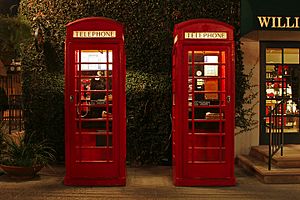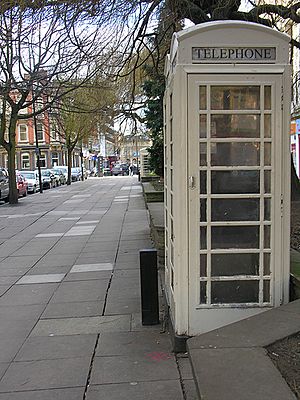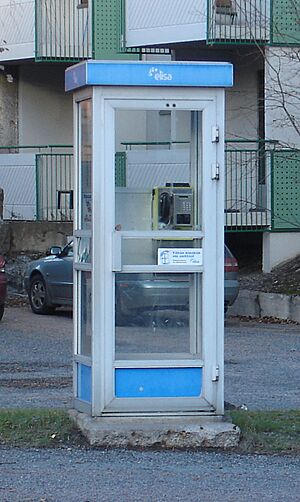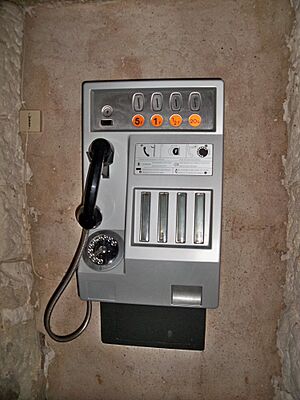Telephone booth facts for kids
A telephone booth (also called a phone booth or phone box) is a small building or space that holds a payphone. It's designed for people to step inside and close the door for some privacy while they make a call.
In countries like the United States and Canada, people usually say "telephone booth" or "phone booth." But in places like the United Kingdom and Australia, they often call it a "phone box."
These booths usually have lights, a door for privacy, and windows so you can see if someone is inside. Sometimes, they even had phone books, paper, a pen, or a seat! Outdoor booths are made of strong materials like metal and plastic to handle weather and lots of use. Indoor booths, once called "silence cabinets," could be much fancier. Most outdoor booths showed the name and logo of the phone company.
Contents
History of Phone Booths
The very first phone box in the world was called "Fernsprechkiosk." It opened on January 12, 1881, in Berlin, Germany. To use it, you had to buy special paper tickets that gave you a few minutes of talk time. Later, in 1899, it was changed to use coins.
In the United States, a person named William Gray is known for inventing the coin-operated payphone in 1889. The first phone booth in London, England, was likely put in place around May 1903.
In the UK, a national network of phone boxes started in 1920 with the K1 model, which was made of concrete. However, the city of Kingston upon Hull had its own phone service, Kingston Communications, which used cream-colored phone boxes instead of the famous red ones.
How Phone Booths Changed
Starting in the 1970s, payphones in the United States were less often placed inside full booths. Many cities replaced them with open payphones. This change happened partly to make phones easier for people with disabilities to use.
However, in the United Kingdom, phones stayed in booths more often. Even so, the number of phone boxes in Britain has dropped a lot since the late 1990s because so many people started using mobile phones.
Some phone booths had special equipment that let people use a computer, a fax machine, or a device for deaf callers.
Privacy and Phone Booths
Phone booths were sometimes watched by law enforcement. For example, a famous court case in the U.S. Supreme Court called Katz v. United States was about whether the Federal Bureau of Investigation (FBI) could put a listening device outside a phone booth. This case helped set rules about people's privacy when making calls.
Paying for Your Call
Coins
To pay for a call, you would put coins into a slot on the phone. With some phones, you put the coins in before you dialed. If the call didn't go through, the coins would come back out. With other phones, you only put in coins after someone answered your call.
Cards
You could also pay for calls using a special payment code, a swipe-card, or a telephone card. Some payphones even had a card reader to let you pay with a credit card.
Collect Calls
If you didn't have money, you could ask the phone company operator to make a "collect call." This meant the person you were calling would pay for the call if they agreed. Sometimes, you could even receive a call at a phone booth if the person knew you were waiting there.
Emergency Calls
Many phone booths allowed you to dial emergency numbers (like 911 or 999) or reach an operator without needing any coins or payment.
Recent Changes
Wireless Services
More and more people using mobile phones has meant fewer people need payphones. But the rise of laptops led to a new idea. In 2003, a company called Verizon started offering wireless internet near their phone booths in Manhattan. This allowed computer users to connect to the internet using a small device inside the booth.
Phone booths have been slowly disappearing since mobile phones became popular in 1973.
Dual Currencies
Many phone booths in Northern Ireland could accept two types of money: Pound sterling and Euro coins. This was because of how close it is to the Republic of Ireland, which uses Euros. Some booths in large cities in Great Britain also accepted both currencies. These booths sometimes offered internet access and text messaging too.
In the United States and Canada, most phone booths could accept both American and Canadian 5¢, 10¢, and 25¢ coins because they are similar in size and weight.
Fewer Phone Booths
Payphones can still be useful if someone's mobile phone breaks, gets stolen, or for other emergencies. This might mean they won't completely disappear very soon.
Australia
In Australia, the government requires the phone company Telstra to make sure payphones are available to everyone. Some communities, especially in remote areas, still rely on payphones, as do people who don't have mobile phones.
At their busiest in the early 1990s, Australia had over 80,000 public phone boxes. By 2016, there were about 24,000. In August 2021, with 15,000 public phones left, Telstra announced that all calls to landlines and mobile phones within Australia from public phones would become free! Telstra also said they didn't plan to remove more public phones.
Belgium
In Belgium, the main phone company, Belgacom, removed its last phone booths on June 1, 2015.
Czechia
On June 17, 2021, the very last phone booth in Czechia was taken down.
Denmark
On December 13, 2017, the last three public phone booths in Denmark had their phones removed. They were in the town of Aarhus.
Finland
By 2007, most phone companies in Finland had stopped offering public phones. The last company, Elisa Oyj, did the same early that year.
France
As of 2021, only 26 public phone booths were still working in France. A law in 2015 ended the requirement for the Orange phone company to keep a network of public phone booths. They are now only kept in rural areas where there is no mobile phone service. They are removed once mobile service becomes available.
Ireland
The main phone company in Ireland, Eir, has been removing payphones that are not used very often. As of June 2019, only 456 locations still had payphones, down from 1,320 in 2014.
Jordan
In 2004, Jordan became the first country in the world to no longer have phone booths widely available. Almost everyone there had a mobile phone, so phone booths were hardly used. The companies that ran payphone services closed down.
Norway
The last working phone box in Norway was taken out of service in June 2016. However, 100 of these phone boxes have been saved and are protected as part of the country's cultural history.
Sweden
The first phone booth in Sweden was put up in 1890. In 1981, there were 44,000 of them! But by 2013, there were only 1,200, and the last one was removed in 2015. A survey in 2013 showed that only 1% of people in Sweden had used a phone booth in the past year.
United Kingdom
The red telephone box is a famous symbol of Britain. The company BT still owns the rights to the designs of many of these phone boxes.
BT is slowly removing public phone boxes from the streets of the UK. They can remove a box without asking if there's another one within 400 meters (about 1,300 feet). If not, they have to talk to the local government first. Some old red phone boxes have been changed for other uses, like becoming small community libraries or holding emergency heart devices.
United States
In 1999, there were about 2 million phone booths in the United States. By 2018, only 5% of them were still working. About one-fifth of America's remaining 100,000 payphones are in New York. However, only 4 traditional phone booths are left in New York City; most have been turned into Wi-Fi hotspots. You can no longer receive calls on them, but outgoing calls are now free.
Smoking Ban
After a smoking ban started in England in 2007, it became against the law to smoke in the famous red telephone boxes (types K2 to K8). This is because these boxes are fully enclosed spaces. Phone companies had to put up "no smoking" signs inside them.
Advertising
Many phone boxes in the United Kingdom now have advertisements on them. Some newer phone boxes are even designed with a phone on one side and a large advertising space on the other. The money from the advertising helps pay for the phone service.
In 2018, a group called the UK Local Government Association pointed out "Trojan" telephone boxes. These are phone boxes that are mostly used for advertising. A loophole in the law allowed them to be put up without special permission, and the LGA wants to close this loophole.
What Replaced Phone Booths?
In the last part of the 1900s, payphones mounted on walls or small stands became more common. These often replaced the older, fully enclosed telephone booths.
-
A person using a Telstra phone box in Australia, after traditional phone booths were phased out.
-
A modern Telstra payphone booth in Australia that also offers Wi-Fi.
-
Payphones mounted on a subway wall in South Korea.
-
An old telephone booth in Ilford, London, no longer in use.
-
A decommissioned telephone booth in Berlin, Germany.
See also
 In Spanish: Cabina telefónica para niños
In Spanish: Cabina telefónica para niños
- Callbox
- Hotspot (Wi-Fi)
- Interactive kiosk
- KX telephone boxes
- Mojave phone booth
- Payphone
- Police box
- Red telephone box
- Giles Gilbert Scott, the English architect who designed the iconic red telephone box
- Phonebooth stuffing


















